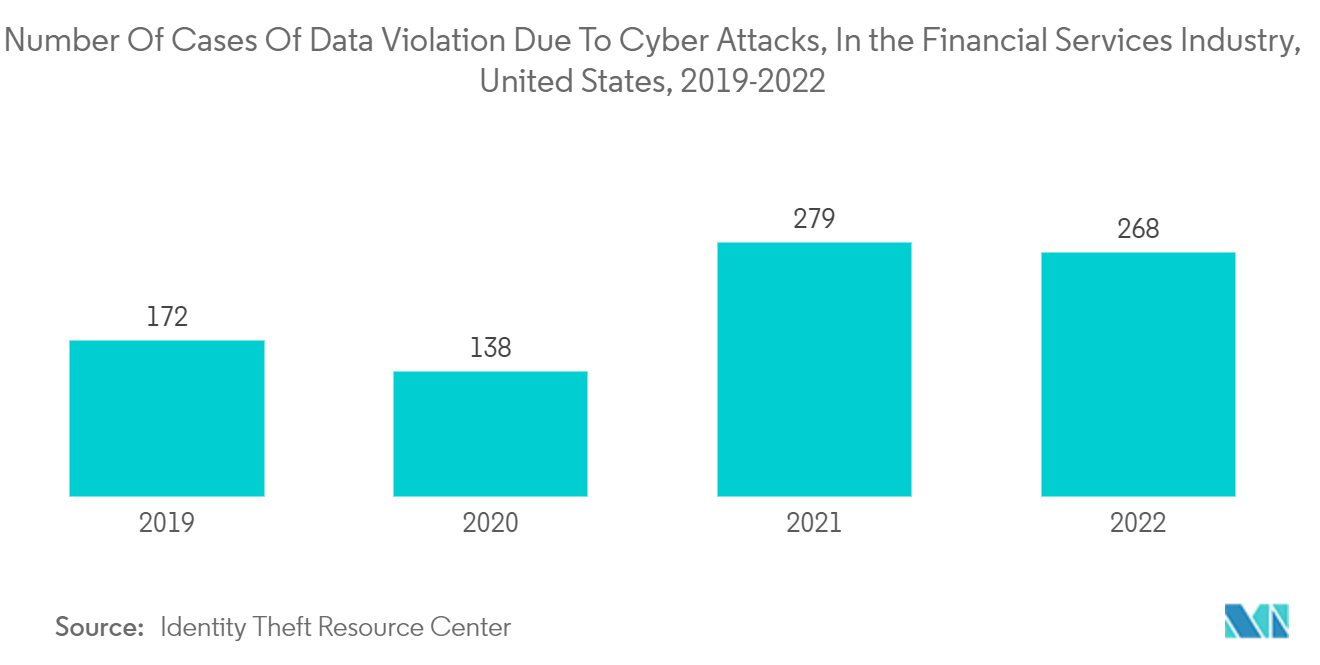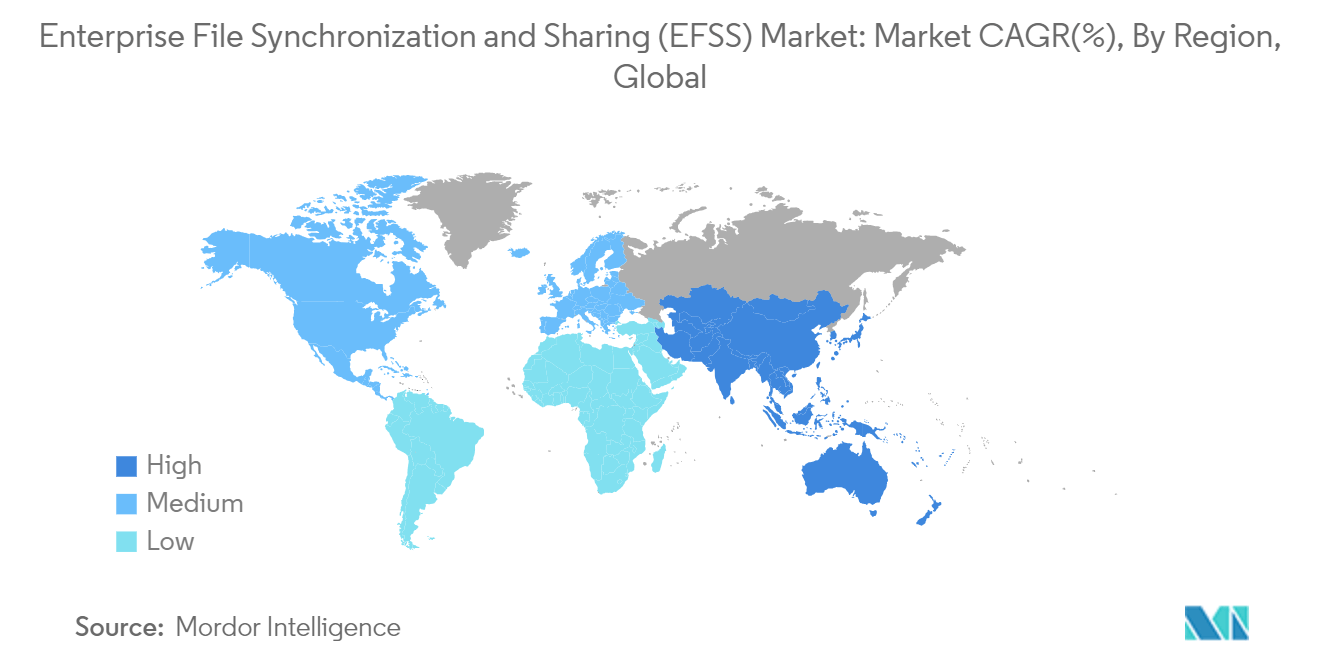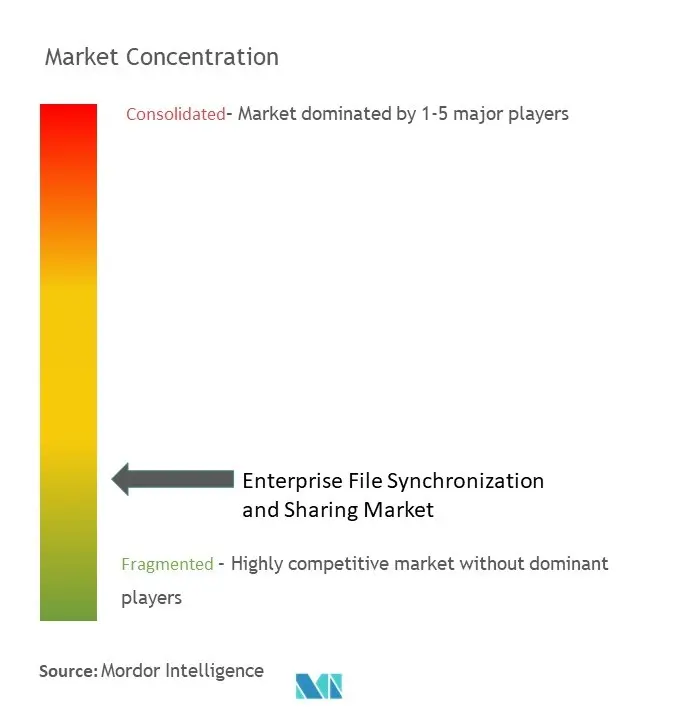Enterprise File Synchronization And Sharing Market Analysis
The Enterprise File Synchronization And Sharing Market size is estimated at USD 15.22 billion in 2025, and is expected to reach USD 45.32 billion by 2030, at a CAGR of 24.38% during the forecast period (2025-2030).
Enterprise file synchronization and sharing (EFSS) is a software service that enables organizations to synchronize and share documents, photos, videos, and files securely.
- Organizations adopt these technologies to help employees avoid using consumer-based file-sharing applications and software to store, access, and manage to ensure data security. For instance, an enterprise workstation dominantly uses Windows, Mac OS, and Linux OS. In contrast, their employees use mobile devices, such as tablets and smartphones, use Android and iOS as the dominant operating systems. It creates a considerable challenge for an organization/institution to create a solution supporting these platforms. This led to the emergence of multiple players in the market that offer EFSS solutions.
- Businesses use EFSS to improve content management, collaboration, and secure file sharing and include features such as live commenting, document version tracking, and workflow process management to help users store, edit, review, and share files.
- It also offers the option to track and trace the document related to any invoice or order in auditing. Large enterprises that utilize EFSS require the flexibility to add access policies that govern the organization's accessibility to access specific content. These products include security capabilities, such as authentication, data encryption, containerization, and tracking features to protect enterprise data. Enterprises have been trying to improve their internal work efficiency by saving their employees time consumed in collaboration, as these solutions enable real-time collaboration and sharing of ideas.
- The increasing adoption of the BYOD policy is driving the market. The growing mobile and digital workplace trends have positively driven the market's growth. File sharing and synchronization tools have become an essential productivity-enabling resource for increasingly mobile information workers, driven by the BYOD policy.
- With the increasing demand for content and information security, enterprises are looking for more advanced solutions than the cloud. Weaknesses in cloud security include theft, sophisticated attacks against the application provider, and the inability to monitor data moving to and from applications. To overcome these, enterprises are launching new solutions.
- However, the organizations also encourage distributing their hardware for the prevalent hybrid work models to ensure uncompromised data security and work quality. Such measures potentially threaten the EFSS market, limiting the precedented growth with concepts like BYOD. The companies continue to use EFSS solutions on their proprietary devices for remote working.
- Further, the COVID-19 pandemic worldwide was anticipated to augment the demand for enterprise file synchronization and sharing, especially among the IT and telecom sectors, due to the feasibility of employees' working from home. This significantly drove the demand for safer enterprise file access, synchronization, and sharing solutions. As a result of the WFH onslaught, companies witnessed stepped-up sales, providing multiple access points and new-age features to ensure smooth and mission-critical performance in client organizations.
Enterprise File Synchronization And Sharing Market Trends
BFSI Segment Is Expected To Account For Significant Market Share
- Capital-intensive financial institutions generally have multiple business lines, leading to several disconnected technology solutions and functions. This has created a demand for unified applications within the overall organization.
- Most BFSI players invest in EFSS to develop mission-critical banking solutions for risk assessment and mitigation in the business prospects preventing the least data breaches. Cloud content management, data, and security management, and using unsanctioned solutions to share files outside the firewall have become primary EFSS functions for deployment among the banking and insurance sectors. Banking institutions have made significant investments.
- Further, the increasing data breaches and incidences of identity thefts make it immensely important for companies to opt for active file management, especially in the banking sector.
- The BFSI sector accounted for the majority of exposed sensitive records. According to moneycontrol.com, in August 2022, the Indian Minister of State in the Ministry of Finance mentioned that the government recorded 248 successful data breaches, comprising card data breaches and other business and non-business data thefts in India. Such figures suggest the need for stringent and robust cloud access and remote file management software in the banking sector.
- Thus, the market studied has been gaining traction. Many banks have been hosting advanced file sharing and synchronization services, which are compatible with their existing IT architecture and capabilities to protect data across all accessing devices, including monitoring, preventing, and resolving any instances of data leakage.
- Lockton (US Insurance Firm), one of the prominent, privately-owned insurance brokerage firms with over 5,600 associates and over 48,000 clients, provided unique file-sharing access to experts. Lockton used ShareFile, a DropBox solution, as a single solution to address mobility requirements while allowing easy and secure file sharing with its clients.
North America is Expected to Hold Major Share
- The region is home to significant markets for managed services, professional services, cloud, IT and telecom, and retail due to the presence of countries such as the United States and Canada. The United States holds a significant share in IT and telecom and its supporting sectors, which may grow even further over the forecast period. The penetration of BYOD and smart device worldwide is significantly driving the market growth for EFSS. The United States holds a prominent share in smart device sales.
- The region's demand for managed services is another driving factor for EFSS, as more and more enterprises opt for outsourcing non-core functionalities. The region is also home to significant vendors in managed services space, and such vendors are growing even further to increase their capabilities.
- EFSS vendors, such as Microsoft, Dropbox, Citrix, Google, VMware, etc., are concentrated in the United States. Because of such scenarios, the region is driving the demand. Also, North America is expected to attain prominent revenue generation due to the high development rate of small and medium businesses. SMEs in the region are increasingly integrating modern technologies, such as mobile and cloud, within conventional EFSS, offering cost benefits.
- The growing number of enterprises catering to global and local clientele increases data privacy concerns. Governments in the region are taking certain steps to regulate citizens' data privacy. For instance, the California Consumer Privacy Act (CCPA) came into effect in January 2020, which applied to a business that collects and processes California residents' data or does business in California. The CCPA also grants rights to consumers similar to the GDPR, including disclosing personal information and requests for personal data.
- Also, the Canadian law Personal Information Protection and Electronic Documents Act (PIPEDA) enforces data privacy and governs how private sector organizations collect, use, and disclose personal information in their businesses. Due to such developments and increasing regional demand, many vendors focus on their regional operations and cross-border operations, which further need even more strict measures to avoid data breaches, targeting seamless management of files and data.
Enterprise File Synchronization And Sharing Industry Overview
The enterprise file synchronization and sharing market is fragmented and intensely competitive. Players use strategies such as new product launches, partnerships, expansions, and others to increase their footprints in this market. The players share resources for mutual benefits. The client companies leverage the solutions the service providers offer to bolster some major functionalities.
- October 2023 - The cloud-based file-sharing company Dropbox Inc. revealed the launch of its new artificial intelligence-based search feature, Dropbox Dash, into open beta test along with enhancements to its AI-powered summarization experience Dropbox AI. The company also announced a new all-in-one tool, Dropbox Studio, allowing customers to capture, edit, and get feedback videos.
- May 2023 - Microsoft announced a new OneDrive experience for work and school that starts with the OneDrive home page and spans file experiences across Microsoft 365. It’s a visual and functional upgrade designed to help you get to files quickly and keep your content organized in multiple ways. The new features and upgraded design make it faster to get to all your personal, shared, and team files in OneDrive so you can be more productive.
Enterprise File Synchronization And Sharing Market Leaders
-
Box, Inc.
-
Citrix Systems, Inc.
-
Dropbox, Inc.
-
Microsoft Corporation
-
Google Inc. (Alphabet Inc.)
- *Disclaimer: Major Players sorted in no particular order
Enterprise File Synchronization And Sharing Market News
- July 2023 - Google has officially released its Nearby Share app for Windows PCs, which makes file-sharing between various devices, including phones, tablets, and Chromebooks, more accessible. The app's official launch included several new improvements, such as the estimated time for file transfers to be completed and image previews within device notifications showing the correct file being shared.
- August 2023 - IBM launched an open-source detection and response framework for MFT attacks. The goal is to help defenders detect attacks enabled by managed file transfer application vulnerabilities more quickly and provide an incident response playbook.
Enterprise File Synchronization And Sharing Industry Segmentation
The enterprise file synchronization and sharing service allows users to save files such as documents, photos, and videos in the cloud or on-premises storage and then access them on other computing devices with multiple people. Increasing privacy and security concerns, the service demand for all organization sizes is growing, comprising various end-user Vertical, such as Telecom and IT, BFSI, Retail, and Manufacturing.
The enterprise file synchronization and sharing market is segmented by service (managed services, professional services), size of enterprise (small and medium enterprises, large enterprises), deployment (cloud, on-premise), end-user vertical (IT & telecom, banking, financial services, and insurance, retail, manufacturing, education, government), and Geography (North America, Europe, Asia-Pacific, Latin America, Middle East & Africa). The market sizes and forecasts are provided in terms of value in (USD) for all the above segments.
| Service | Managed Service |
| Professional Service | |
| Size of Enterprise | Small and Medium Enterprises |
| Large Enterprises | |
| Deployment Type | On-premise |
| Cloud | |
| End-user Vertical | IT & Telecom |
| Banking, Financial Services and Insurance | |
| Retail | |
| Manufacturing | |
| Education | |
| Government | |
| Other End-user Verticals | |
| Geography | North America |
| Europe | |
| Asia-Pacific | |
| Latin America | |
| Middle East and Africa |
EFSS Market Research FAQs
How big is the Enterprise File Synchronization And Sharing Market?
The Enterprise File Synchronization And Sharing Market size is expected to reach USD 15.22 billion in 2025 and grow at a CAGR of 24.38% to reach USD 45.32 billion by 2030.
What is the current Enterprise File Synchronization And Sharing Market size?
In 2025, the Enterprise File Synchronization And Sharing Market size is expected to reach USD 15.22 billion.
Who are the key players in Enterprise File Synchronization And Sharing Market?
Box, Inc., Citrix Systems, Inc., Dropbox, Inc., Microsoft Corporation and Google Inc. (Alphabet Inc.) are the major companies operating in the Enterprise File Synchronization And Sharing Market.
Which is the fastest growing region in Enterprise File Synchronization And Sharing Market?
Asia Pacific is estimated to grow at the highest CAGR over the forecast period (2025-2030).
Which region has the biggest share in Enterprise File Synchronization And Sharing Market?
In 2025, the North America accounts for the largest market share in Enterprise File Synchronization And Sharing Market.
What years does this Enterprise File Synchronization And Sharing Market cover, and what was the market size in 2024?
In 2024, the Enterprise File Synchronization And Sharing Market size was estimated at USD 11.51 billion. The report covers the Enterprise File Synchronization And Sharing Market historical market size for years: 2019, 2020, 2021, 2022, 2023 and 2024. The report also forecasts the Enterprise File Synchronization And Sharing Market size for years: 2025, 2026, 2027, 2028, 2029 and 2030.
Our Best Selling Reports
EFSS Industry Report
Statistics for the 2025 Enterprise File Synchronization And Sharing market share, size and revenue growth rate, created by Mordor Intelligence™ Industry Reports. Enterprise File Synchronization And Sharing analysis includes a market forecast outlook for 2025 to 2030 and historical overview. Get a sample of this industry analysis as a free report PDF download.







